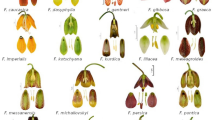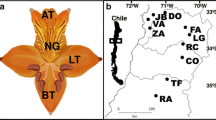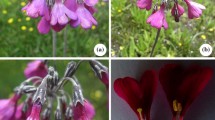Abstract
In most pollination systems, animals transfer pollen among plants of a given species. Pollinator visitations do not come without cost, so plants usually offer a reward. However, the flowers of some plant species, mostly orchids, lack rewards and deceive animals into visiting their flowers. Deceptive species are thought to have high levels of variation in traits associated with advertisement and pollinator attraction, which have been attributed to genetic drift, or disruptive selection due to pollinator behavior. Rewarding species are assumed to have less variation due to stabilizing selection. We compared variability in floral morphology and fragrance composition between deceptive and rewarding species. Because both suites of traits are often linked with floral advertisement and pollinator attraction, we expected variation to be greater in species with deceptive pollination systems than in those offering rewards. We obtained floral morphology metrics for 20 deceptive species and 41 rewarding species native or naturalized in Puerto Rico, Venezuela, and Ecuador. Floral fragrances were sampled from eight deceptive species and four rewarding species. We found that the amplitude of variation in floral morphology and fragrance composition covaries significantly. Comparison of coefficients of variation for morphology indicated that, overall, deceptive species show significantly higher variation than rewarding species, and this pattern was also found among just orchids or just nonorchids. There were no statistical differences in morphological variation between orchids and nonorchids within a functional pollination group. Fragrance variation, measured by Jaccard distance, tended to be greater for deceptive species than for rewarding species. Although overlap in measures of variation occurs between the two groups, the data support the hypothesis that populations of deception-pollinated species are more variable than rewarding species in traits associated with pollinator attraction.


Similar content being viewed by others
References
Ackerman JD (1981) Pollination biology of Calypso bulbosa var. occidentalis (Orchidaceae): a food deception system. Madroño 28:101–109
Ackerman JD (1983) Euglossine bee pollination of the orchid, Cochleanthes lipscombiae: a food source mimic. Am J Bot 70:830–834
Ackerman JD (1986) Mechanisms and evolution of food-deceptive pollination systems in orchids. Lindleyana 1:108–113
Ackerman JD, Carromero W (2005) Is reproductive success related to color polymorphism in a deception-pollinated, tropical terrestrial orchid? Caribb J Sci 41:234–242
Ackerman JD, Galarza-Pérez M (1991) Patterns and maintenance of extraordinary variation in the Caribbean orchid, Tolumnia (Oncidium) variegata. Syst Bot 16:182–194
Ackerman JD, Zimmerman JK (1994) Bottlenecks in the life histories of orchids: resources, pollination, population structure, and seedling establishment. In: Pridgeon A (ed) Proceedings of the 14th world orchid conference. Her Majesty’s Stationery Office, London, pp 125–129
Ackerman JD, Meléndez-Ackerman EJ, Salguero-Faría J (1997) Variation in pollinator abundance and selection on fragrance phenotypes in an epiphytic orchid. Am J Bot 84:1383–1390
Anderson E, Hubricht L (1938) Hybridization in Tradescantia. III. The evidence for introgressive hybridization. Am J Bot 25:396–402
Aragón S, Ackerman JD (2004) Does flower color variation matter in deception pollinated Psychilis monensis (Orchidaceae)? Oecologia 138:405–413
Ayasse M, Schiestl FP, Paulus HF, Lofstedt C, Hansson B, Ibarra F, Francke W (2000) Evolution of reproductive strategies in the sexually deceptive orchid Ophrys sphegodes: how does flower-specific variation of odor signals influence reproductive success? Evolution 54:1995–2006
Blanco M, Barbosa G (2005) Pseudocopulatory pollination in Lepanthes (Orchidaceae: Pleurothallidinae) by fungus gnats. Ann Bot 95:763–772
Dafni A (1984) Mimicry and deception in pollination. Ann Rev Ecol Syst 15:259–278
Dafni A (1992) Pollination ecology. A practical approach. Oxford University Press, Oxford
Dressler RL (2005) Sobralia. In: Pridgeon AM, Cribb PJ, Chase MW, Rasmussen FN (eds) General orchidacearum volume 4. Epidendroideae (Part one). Oxford University Press, Oxford, pp 601–604
Ellstrand NC, Schierenbeck KA (2000) Hybridization as a stimulus for the evolution of invasiveness in plants? Proc Natl Acad Sci USA 97:7043–7050
Gentry AL (1974) Flowering phenology and diversity in tropical Bignoniaceae. Biotropica 6:64–68
Gentry AL, Dodson CH (1987) Diversity and biogeography of neotropical vascular epiphytes. Ann Missouri Bot Gard 74:205–233
Gigord LDB, Macnair MR, Smithson A (2001) Negative frequency-dependent selection maintains a dramatic flower color polymorphism in the rewardless orchid Dactylorhiza sambucina (L.) Soò. Proc Natl Acad Sci USA 98:6253–6255
Gorlo D, Wolska L, Zygmunt J, Namiesnik J (1997) Calibration procedure for solid phase microextraction-gas chromatographic analysis of organic vapours in air. Talanta 44:1543–1550
Haber WA (1984) Pollination by deceit in a mass flowering tropical tree Plumeria rubra L. (Apocynaceae). Biotropica 16:269–275
Heinrich B (1975) Bee flowers: a hypothesis on flower variety and blooming times. Evolution 29:325–334
Heinrich B (1976) The foraging specializations of individual bumblebees. Ecol Monogr 46:1105–1128
Jersáková J, Johnson SD, Kindelmann P (2006a) Mechanisms and evolution of deceptive pollination in orchids. Biol Rev 81:219–235
Jersáková J, Kindlmann P, Renner SS (2006b) Is colour dimorphism in Dactylorhiza sambucina maintained by differential seed viability instead of frequency-dependent selection? Fol Geobot 41:61–76
Johnson SD, Linder HP, Steiner KE (1998) Phylogeny and radiation of pollination systems in Disa (Orchidaceae). Am J Bot 85:402–411
Kunze J, Gumbert A (2001) The combined effect of color and odor on flower choice behavior of bumble bees in flower mimicry systems. Behav Ecol 12:447–457
Little RJ (1983) A review of floral food deception mimicries with comments on floral mutualism. In: Jones CE, Little RJ (eds) Handbook of experimental pollination biology. Scientific and Academic Editions, New York, pp 294–309
Lockwood JL, Hoopes MF, Marchetti MP (2007) Invasion ecology. Blackwell, Malden
Luo Y-B, Chen S-C (2008) Observations of putative pollinators of Hemipilia flabellata Bur. et Franch. (Orchidaceae) in north–west Yunnan Province, China. Bot J Linn Soc 131:45–64
McCune B, Grace JB (2002) Analysis of ecological communities. MjM Software, Gleneden Beach, Oregon
McCune B, Mefford MJ (2006) Multivariate analysis of ecological data. Version 5.19. MjM Software, Gleneden Beach, Oregon
Meléndez-Ackerman EJ, Campbell DR, Waser NM (1997) Hummingbird behavior and mechanisms of selection on flower color in Ipomopsis. Ecology 78:2532–2541
Morales M, Ackerman JD, Tremblay RL (2010) Morphological flexibility across an environmental gradient in the epiphytic orchid, Tolumnia variegata: complicating patterns of fitness. Bot J Linn Soc 163:431–446
Moya S, Ackerman JD (1993) Variation in the floral fragrance of Epidendrum ciliare (Orchidaceae). Nordic J Bot 13:41–47
Nassar JM, Ramírez N, Linares O (1997) Comparative pollination biology of Venezuelan columnar cacti and the role of nectar-feeding bats in their sexual reproduction. Am J Bot 84:918–927
Neiland MR, Wilcock CC (1998) Fruit set, nectar reward, and rarity in the Orchidaceae. Am J Bot 85:1657–1671
Nielsen LR (2000) Natural hybridization between Vanilla claviculata (W. Wright) Sw. and V. barbellata Rchb. f. (Orchidaceae): genetic, morphological, and pollination experimental data. Bot J Linn Soc 133:285–302
Nilsson LA (1980) The pollination ecology of Dactylorhiza sambucina (Orchidaceae). Bot Not 133:367–385
Nilsson LA (1992) Orchid pollination biology. Trends Ecol Evol 7:255–259
Pérez JE, Alfonsi C, Nirchio M, Barrios J (2006) The inbreeding paradox in invasive species. Interciencia 31:54–546
Raguso RA (2008) Wake up and smell the roses: the ecology and evolution of floral scent. Ann Rev Ecol Evol Syst 39:549–569
Renner SS (2006) Rewardless flowers in the angiosperms and the role of insect cognition in their evolution. In: Waser NM, Ollerton J (eds) Plant-pollinator interactions: from specialization to generalization. University of Chicago Press, Chicago, pp 123–144
Rivera-Marchand B, Ackerman JD (2006) Bat pollination breakdown in a Caribbean columnar cactus, Pilosocereus royenii. Biotropica 38:635–642
Sakai S, Inoue T (1999) A new pollination system: dung-beetle pollination discovered in Orchidantha inouei (Lowiaceae, Zingerbales) in Sarawak, Malaysia. Am J Bot 86:56–61
Salzmann CC, Schiestl FP (2007) Odour and colour polymorphism in the food-deceptive orchid Dactylorhiza romana. Pl Syst Evol 267:37–45
Salzmann CC, Nardella AM, Cozzolino S, Schiestl FP (2007a) Variability in floral scent in rewarding and deceptive orchids: the signature of pollinator-imposed selection? Ann Bot 100:757–765
Salzmann CC, Cozzolino S, Schiestl FP (2007b) Floral scent in food-deceptive orchids: species specificity and sources of variability. Pl Biol 9:720–729
Schemske DW, Bierzychudek P (2001) Perspective: evolution of flower color in the desert annual Linanthus parryae: Wright revisited. Evolution 55:1269–1282
Simpson BB, Neff JL (1983) Evolution and diversity of floral rewards. In: Jones CE, Little RJ (eds) Handbook of experimental pollination biology. Scientific and Academic Editions, New York, pp 142–159
Smithson A, Macnair MR (1997) Negative frequency-dependent selection by pollinators on artificial flowers without rewards. Evolution 51:715–723
Tremblay RL, Ackerman JD (2001) Gene flow and effective population size in Lepanthes (Orchidaceae): a case for genetic drift. Biol J Linn Soc 72:47–62
Tremblay RL, Ackerman JD (2007) Floral color patterns in a tropical orchid: are they associated with reproductive success? Pl Sp Biol 22:95–105
Tremblay RL, Ackerman JD, Zimmerman JK, Calvo RN (2005) Variation in sexual reproduction in orchids and its evolutionary consequences: a spasmodic journey to diversification. Biol J Linn Soc 84:1–54
Tremblay RL, Ackerman JD, Pérez ME (2010) Riding across the selection landscape: fitness consequences of annual variation in reproductive characteristics. Phil Trans Roy Soc B 365:491–498
van der Pijl L, Dodson CH (1966) Orchid flowers: their pollination and evolution. University of Miami Press, Coral Gables
Wang T, Su Y, Chen G (2008) Population genetic variation and structure of the invasive weed Mikania micrantha in southern China: consequences of rapid range expansion. J Heredity 99:22–33
Zimmerman JK, Aide TM (1989) Patterns of fruit production in a neotropical orchid: pollinator vs. resource limitation. Am J Bot 76:67–73
Acknowledgments
We thank Jess Zimmerman for his advice concerning Jaccard distances, and Osvaldo Rosario for his guidance in interpreting GC/MS data. We also thank R. Tremblay for fieldwork assistance, M. Aponte, Y. Marrero, and I. Rivera for help with laboratory work, and R. Almodovar, R. Blanco, and R. Morales for technical assistance with GC/MS. This work was supported by National Science Foundation grants to J.D.A. (HRD-9353549, DEB-9505459, HRD-9628475) and the NSF-REU program in tropical ecology at the El Verde Field Station of the Institute for Tropical Ecosystems Ecology, University of Puerto Rico, Río Piedras (NSF-DBI 9912316 to Eliva J. Meléndez-Ackerman).
Author information
Authors and Affiliations
Corresponding author
Rights and permissions
About this article
Cite this article
Ackerman, J.D., Cuevas, A.A. & Hof, D. Are deception-pollinated species more variable than those offering a reward?. Plant Syst Evol 293, 91–99 (2011). https://doi.org/10.1007/s00606-011-0430-6
Received:
Accepted:
Published:
Issue Date:
DOI: https://doi.org/10.1007/s00606-011-0430-6




